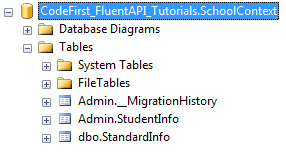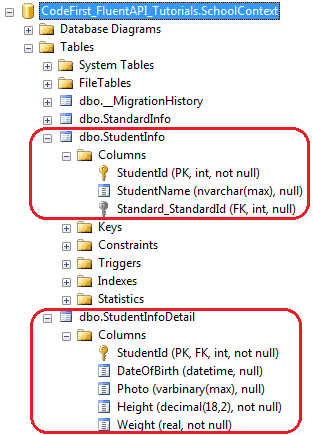Entity Framework Code-First(10.2):Entity Mappings
Entity Mappings using Fluent API:
Here, we will learn how to configure an entity using Fluent API.
We will use the following Student and Standard domain classes of the school application.
public class Student
{
public Student()
{ }
public int StudentID { get; set; }
public string StudentName { get; set; }
public DateTime? DateOfBirth { get; set; }
public byte[] Photo { get; set; }
public decimal Height { get; set; }
public float Weight { get; set; } public Standard Standard { get; set; }
} public class Standard
{
public Standard()
{ }
public int StandardId { get; set; }
public string StandardName { get; set; } public ICollection<Student> Students { get; set; } }
Configure Default Schema:
First, let's configure a default schema for the tables in the database. However, you can change the schema while creating the individual tables. The following example sets the default Admin schema.
public class SchoolContext: DbContext
{
public SchoolDBContext(): base()
{
} public DbSet<Student> Students { get; set; }
public DbSet<Standard> Standards { get; set; } protected override void OnModelCreating(DbModelBuilder modelBuilder)
{
//Configure default schema
modelBuilder.HasDefaultSchema("Admin");
}
}
Map Entity to Table:
Code-First will create the database tables with the name of DbSet properties in the context class - Students and Standards in this case. You can override this convention and can give a different table name than the DbSet properties, as shown below.
namespace CodeFirst_FluentAPI_Tutorials
{ public class SchoolContext: DbContext
{
public SchoolDBContext(): base()
{
} public DbSet<Student> Students { get; set; }
public DbSet<Standard> Standards { get; set; } protected override void OnModelCreating(DbModelBuilder modelBuilder)
{
//Configure default schema
modelBuilder.HasDefaultSchema("Admin"); //Map entity to table
modelBuilder.Entity<Student>().ToTable("StudentInfo");
modelBuilder.Entity<Standard>().ToTable("StandardInfo","dbo"); }
}
}
As you can see in the above example, we start with the Entity<TEntity>() method. Most of the time, you have to start with the Entity<TEntity>() method to configure it using Fluent API. We have used ToTable() method to map Student entity to StudentInfo and Standard entity to StandardInfo table. Notice that StudentInfo is in Admin schema and StandardInfo table is in dbo schema because we have specified dbo schema for StandardInfo table.

Map Entity to Multiple Table:
The following example shows how to map Student entity to multiple tables in the database.
namespace CodeFirst_FluentAPI_Tutorials
{ public class SchoolContext: DbContext
{
public SchoolDBContext(): base()
{
} public DbSet<Student> Students { get; set; }
public DbSet<Standard> Standards { get; set; } protected override void OnModelCreating(DbModelBuilder modelBuilder)
{
modelBuilder.Entity<Student>().Map(m =>
{
m.Properties(p => new { p.StudentId, p.StudentName});
m.ToTable("StudentInfo"); }).Map(m => {
m.Properties(p => new { p.StudentId, p.Height, p.Weight, p.Photo, p.DateOfBirth});
m.ToTable("StudentInfoDetail"); }); modelBuilder.Entity<Standard>().ToTable("StandardInfo"); }
}
}
As you can see in the above example, we mapped some properties of Student entity to StudentInfo table and other properties to StudentInfoDetail table using Map() method. Thus, Student entity will split into two tables, as shown below.

Map method need the delegate method as a parameter. You can pass Action delegate or lambda expression in Map method, as shown below.
using System.Data.Entity.ModelConfiguration.Configuration; namespace CodeFirst_FluentAPI_Tutorials
{ public class SchoolContext: DbContext
{
public SchoolDBContext(): base()
{
} public DbSet<Student> Students { get; set; }
public DbSet<Standard> Standards { get; set; } protected override void OnModelCreating(DbModelBuilder modelBuilder)
{
modelBuilder.Entity<Student>().Map(delegate(EntityMappingConfiguration<Student> studentConfig)
{
studentConfig.Properties(p => new { p.StudentId, p.StudentName });
studentConfig.ToTable("StudentInfo");
}); Action<EntityMappingConfiguration<Student>> studentMapping = m =>
{
m.Properties(p => new { p.StudentId, p.Height, p.Weight, p.Photo, p.DateOfBirth });
m.ToTable("StudentInfoDetail");
};
modelBuilder.Entity<Student>().Map(studentMapping); modelBuilder.Entity<Standard>().ToTable("StandardInfo"); }
}
}
Entity Framework Code-First(10.2):Entity Mappings的更多相关文章
- Entity Framework Code-First(10.3):Property Mappings
Property Mappings using Fluent API: Here, we will learn how to configure properties of an entity cla ...
- Entity Framework Code first(转载)
一.Entity Framework Code first(代码优先)使用过程 1.1Entity Framework 代码优先简介 不得不提Entity Framework Code First这个 ...
- ASP.NET MVC深入浅出系列(持续更新) ORM系列之Entity FrameWork详解(持续更新) 第十六节:语法总结(3)(C#6.0和C#7.0新语法) 第三节:深度剖析各类数据结构(Array、List、Queue、Stack)及线程安全问题和yeild关键字 各种通讯连接方式 设计模式篇 第十二节: 总结Quartz.Net几种部署模式(IIS、Exe、服务部署【借
ASP.NET MVC深入浅出系列(持续更新) 一. ASP.NET体系 从事.Net开发以来,最先接触的Web开发框架是Asp.Net WebForm,该框架高度封装,为了隐藏Http的无状态模 ...
- Entity Framework Code First (三)Data Annotations
Entity Framework Code First 利用一种被称为约定(Conventions)优于配置(Configuration)的编程模式允许你使用自己的 domain classes 来表 ...
- Entity Framework Code First (二)Custom Conventions
---------------------------------------------------------------------------------------------------- ...
- Entity Framework Code First (一)Conventions
Entity Framework 简言之就是一个ORM(Object-Relational Mapper)框架. Code First 使得你能够通过C#的类来描述一个模型,模型如何被发现/检测就是通 ...
- Entity Framework Code First (七)空间数据类型 Spatial Data Types
声明:本文针对 EF5+, Visual Studio 2012+ 空间数据类型(Spatial Data Types)是在 EF5 中引入的,空间数据类型表现有两种: Geography (地理学上 ...
- Entity Framework Code First (四)Fluent API - 配置属性/类型
上篇博文说过当我们定义的类不能遵循约定(Conventions)的时候,Code First 提供了两种方式来配置你的类:DataAnnotations 和 Fluent API, 本文将关注 Flu ...
- Entity Framework Code First (八)迁移 Migrations
创建初始模型和数据库 在开始使用迁移(Migrations)之前,我们需要一个 Project 和一个 Code First Model, 对于本文将使用典型的 Blog 和 Post 模型 创建一个 ...
随机推荐
- jQuery水平滑动菜单
在线演示 本地下载
- autoplay移动端不能自动播放
本文总结自:https://stackoverflow.com/questions/12496144/can-you-autoplay-html5-videos-on-the-ipad 首先,自动播放 ...
- mini2440移植uboot 2014.04(一)
最新版的uboot添加了很多新功能,我决定在最新版代码基础上重新移植一遍加深理解. 我修改的代码已经上传到github上,地址:https://github.com/qiaoyuguo/u-boot- ...
- 分享知识-快乐自己:关于 String 小案例
单个字符出现的次数: /*** * 验证是否符合拆分条件 * * @param text * 原字符串 * @param sub * 判断条件 * @return */ public static i ...
- csv+jenkins+ant测试接口
1.文件目录 jmeter_test case 用于存放case,csv或者txt格式,jmeter能读取的 result_log 用于存放报告 html 存放html报告 jtl 存放jtl文件 s ...
- Selenium-使用firepath获取元素的xpath
- PHP 使用header函数设置HTTP头的示例解析 表头
PHP 使用header函数设置HTTP头的示例解析 表头 //定义编码 header( 'Content-Type:text/html;charset=utf-8 '); //Atom header ...
- 【构建二叉树】01根据前序和中序序列构造二叉树【Construct Binary Tree from Preorder and Inorder Traversal】
我们都知道,已知前序和中序的序列是可以唯一确定一个二叉树的. 初始化时候二叉树为:================== 前序遍历序列, O================= 中序遍 ...
- bzoj 3232: 圈地游戏 01分数规划
题目大意: http://www.lydsy.com/JudgeOnline/problem.php?id=3232 题解: 首先我们看到这道题让我们最优化一个分式. 所以我们应该自然而然地想到01分 ...
- 洛谷【P3908】异或之和
二进制前置技能:https://www.cnblogs.com/AKMer/p/9698694.html 题目传送门:https://www.luogu.org/problemnew/show/P39 ...
